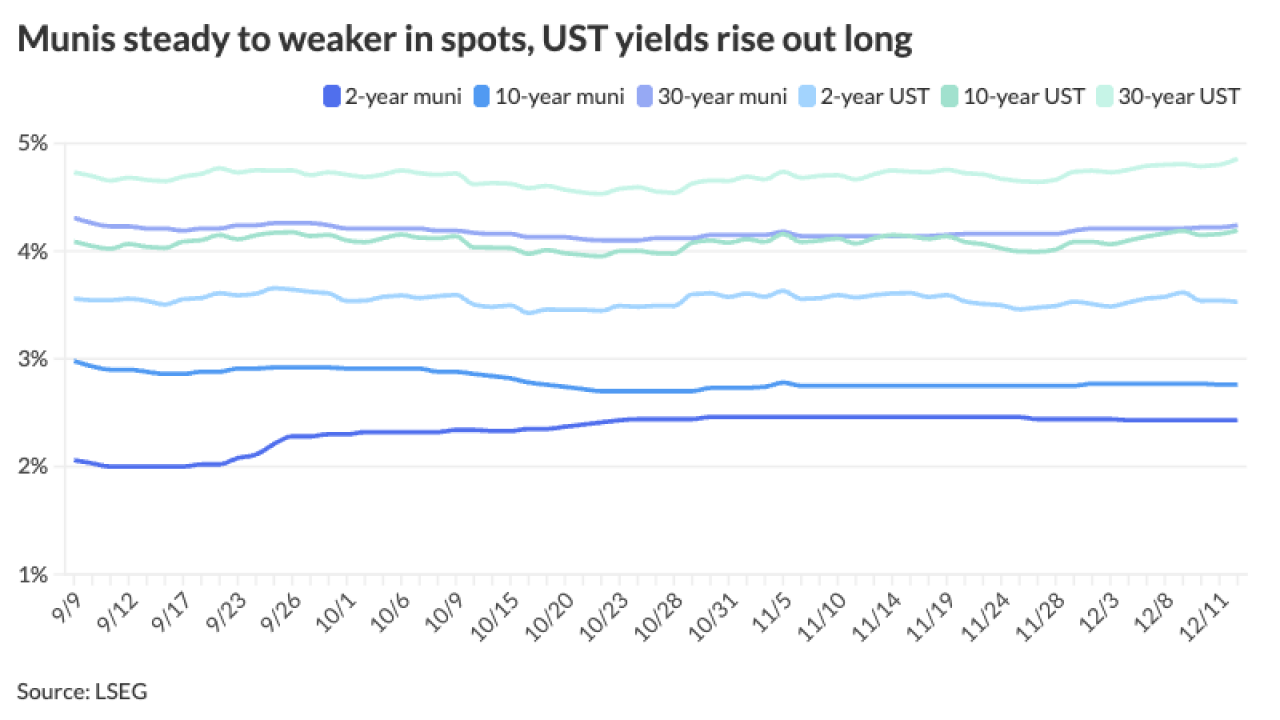Issuance in 2024 surged to a record $500 billion-plus figure, as infrastructure spending needs, election-related concerns and a slew of mega deals led issuers to come to market en masse.
The muni market saw a record $507.585 billion of debt issued in 2024, up 31.8% from $385.061 billion in 2023, according to LSEG data. This surpasses the
Tax-exempt issuance rose 36% to $446.673 billion from $328.536 billion in 2023. Taxable issuance dropped 10.5% to $35.632 billion from $39.817 billion in 2023.
Refundings were up 63.6% to $84.479 billion from $51.646 billion in 2023. New-money volume rose 19% to $355.607 billion from $298.779 billion in 2023.
Most firms believed volume would rise year-over-year in 2024, particularly after
However, the
None, though, predicted issuance would top 2020's and 2021's record levels, let alone surpass $500 billion, but as issuance continued to surge during the second half of the year, market participants realized that might be a real possibility.
Issuance this year was "fairly well placed, given the volatility," said Kim Olsan, senior fixed income portfolio manager at NewSquare Capital. "We are definitely at a higher trading range."
While there were some rally periods, overall, the higher yield range actually helped issuers, she said. This year was a "Goldilocks year" of yield for buyers and fair yields for issuers to print deals, she said.
The higher rates were not so onerous from an issuer's perspective and "there was plenty of buying," including exchange-traded funds and some crossover activity when things pulled back a bit, Olsan said.
Infrastructure upgrades accounted for some of the surge in issuance.
The stimulus money provided in 2021 and 2022 meant municipalities and issuers did not have to issue bonds to fund their operations as there was plenty of cash on hand, said Chris Brigati, managing director and chief investment officer of SWBC.
"They built up cash reserves because they received stimulus money and had other sources of revenue from which they could fund operations," he said.
But with federal aid drying up, issuers had to tap the market to address their infrastructure needs that could no longer ignored, he said.
This becomes increasingly important as some states and cities have a "growth spurt" of sorts where highways need to be extended due to "urban sprawl" and more hospitals, police departments, schools and airports are needed to address the growing populations in
"The demand for infrastructure needs is bigger than it has ever been," he said.
The summer months proved to be strong months for issuance with little drop-off. That helped push total issuance numbers to "further heights" throughout the year, riding the wave through the end of October, which Brigati noted boasted the largest monthly issuance figure at a whopping $64.643 billion..
October's surging issuance following the pattern of an influx of supply the month before the presidential cycle as seen in 2016 and 2020.
"The October number this year had everything to do with how the election was playing out, and unknowns related to that," Olsan said.
Some issuance was also pulled forward ahead of the presidential election in November as market participants wanted to avoid any election-related volatility, which ended up being short-lived, Brigati said.
"Issuers, like everyone else, dislike uncertainties, so they tend to want to lock in something when they know what they're getting," he said. "And even though rates were higher at some points during the year, the issuers were still saying, 'Well, let me at least lock this in before we get to the uncertainty around the election.'"
Additionally, mega deals gained prominence this year as issuers no longer hesitated to bring billion-dollar-plus deals to market, Olsan said.
The number of mega deals coming to market has grown on an almost consecutive year basis, she noted.
Ten years ago, it was unclear how mega deals would be received. However, this year has proven positive reception to them, Olsan said.
"You have a lot of liquidity in those deals, and so it can bring in a larger group of buyers," Olsan said.
Most of the year's larger deals, excluding the Brightline deals, were "well into investment grade, so it isn't much of a credit impact once you get to that deal size," she added.
Going into 2025,
| Don't miss The Bond Buyer's NATIONAL OUTLOOK conference, Feb. 6, in New York City, where experts will delve into issuance expectations, policy developments, credit outlooks and more. |
While interest rates, inflation and macroeconomic policy will play a role in the total,
Most on the Street expect issuance to be around $500 billion, but a few think volume will be much higher, mostly due to the expectation that some issuers will flood the market to get ahead of any
December issuance details
December municipal bond issuance, at $31.646 billion, was up 14.6% year-over-year from $27.614 billion in 2023.
Tax-exempt issuance was up 20.9% to $27.553 billion in 510 issues from $22.785 billion in 462 issues in 2023.
Taxable issuance dropped 48.9% to $2.13 billion in 53 issues from $4.164 billion in 58 issues a year ago. Alternative minimum tax issuance surged 195.4% to $1.963 billion from $664.6 million.
New-money issuance rose 23.4% to $26.128 billion from $21.175 billion last year. Refundings fell 19% to $4.236 billion from $5.228 billion.
Issuance of revenue bonds increased 21.1% to $24.044 billion from $19.86 billion in December 2023, and general obligation bond sales ticked down 2% to $7.602 billion from $7.754 billion in 2023.
Negotiated deal volume was up 59.6% to $27.742 billion from $17.383 billion a year prior. Competitive sales decreased 33.4% to $3.484 billion from $5.228 billion in 2023.
Deals wrapped by bond insurance in December increased 40.8% to $1.775 billion in 89 deals from $1.246 billion in 62 deals a year prior.
Bank-qualified issuance rose $498.2 million in 119 deals from $388.7 million in 100 deals in 2023, a 28.2% increase.
In the states, California accounted for the most volume in 2024.
Issuers in the Golden State sold $71.601 billion, a 31.4% increase year-over-year.
The rest of the top 10 are: Pennsylvania with $16.434 billion, up 35.8%; Massachusetts with $14.34 billion, up 65.3%; Washington with $13.665 billion, up 45.7%; Alabama at $13.569 billion, up 81.9%; and New Jersey with $12.766 billion, a 67.7% increase from 2023.





